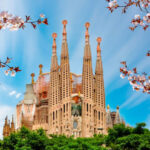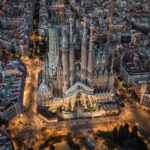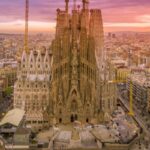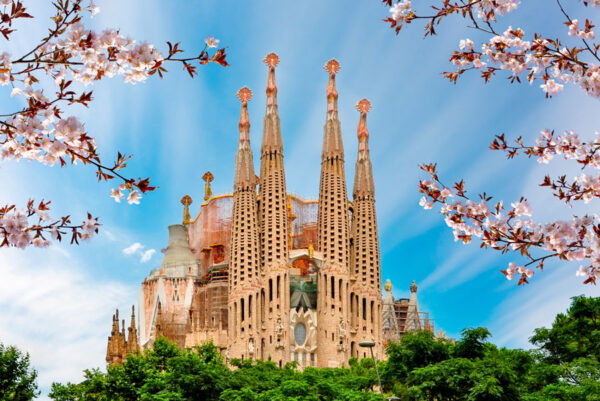
The Sagrada Familia, a masterpiece of architectural innovation and artistic vision, stands as a testament to Barcelona's rich cultural heritage. Its intricate design and monumental scale have captivated visitors for over a century, making it one of the most recognized landmarks in the world.
In this article, we delve into The Fascinating History of Sagrada Familia: Exploring Barcelona's Iconic Landmark, tracing its origins from the ambitious dreams of Antoni Gaudí to the ongoing efforts to complete this iconic basilica. Each stone and spire tells a story, reflecting the passion and dedication of countless artisans who have contributed to its grandeur.
The Architectural Marvel of Sagrada Familia: A Deep Dive into Gaudí's Vision
The Sagrada Familia is more than just a church; it is a symbol of architectural innovation that embodies Antoni Gaudí's unique vision. His approach to design was heavily influenced by nature, resulting in organic shapes and structures that mimic the forms found in the natural world. Gaudí's use of geometric configurations and vibrant colors creates an experience that transports visitors into a realm of wonder.
One of the most remarkable aspects of the Sagrada Familia is its intricate façade, which tells biblical stories through elaborate sculptures. Each side of the basilica represents different themes:
- The Nativity Facade, celebrating the birth of Jesus
- The Passion Facade, depicting the suffering of Christ
- The Glory Facade, symbolizing the resurrection and glory of Jesus
This detailed storytelling through stone showcases Gaudí’s intention to make the church an educational tool, bringing the scriptures to life through visual art.
In addition to its façades, the interior of the Sagrada Familia is equally mesmerizing. Gaudí designed the columns to resemble trees, creating an enchanting forest-like atmosphere. The interplay of light through the stained glass windows paints the interior in stunning hues, enhancing the spiritual experience for visitors. This innovative use of light and space exemplifies Gaudí’s mastery in architectural design.
As the construction of the Sagrada Familia continues, the project remains a collaborative effort involving numerous architects and artisans. The integration of modern technology with Gaudí’s original plans ensures that this architectural marvel will not only honor its creator’s vision but will also adapt to the needs of a contemporary audience. The Sagrada Familia stands as a timeless testament to creativity, dedication, and faith, making it a compelling subject for exploration.
Unraveling the Symbolism Behind Sagrada Familia's Design Elements
The Sagrada Familia's design is a tapestry of symbolism that reflects both religious beliefs and natural elements. Antoni Gaudí infused the basilica with meanings that go beyond its visual appeal, as each design choice serves a purpose. For instance, the use of organic shapes mimics the forms found in nature, illustrating the connection between the divine and the world around us. This choice not only enhances the structural integrity but also underscores the harmony Gaudí envisioned between humanity and the environment.
Additionally, the basilica's towers are laden with meaning. Each of the 18 towers is dedicated to a significant religious figure, including Jesus, Mary, and the apostles, representing a heavenly ascent. The tallest tower, reaching 172.5 meters, is dedicated to Jesus Christ and symbolizes his position as the focal point of Christian faith. This verticality is not merely architectural; it embodies the aspiration of the faithful to reach the divine.
Another compelling aspect of Sagrada Familia's design is the intricate use of light. The stained glass windows are strategically placed to allow sunlight to filter through, casting vibrant colors across the interior. This play of light symbolizes the presence of the Holy Spirit, creating a serene and transcendent atmosphere. As visitors move through the space, they experience a dynamic interpretation of light that evolves with the time of day, enhancing their spiritual journey.
Finally, Gaudí’s integration of natural elements extends to the overall structure, where the basilica’s layout resembles a cross, aligning with traditional Christian architecture. The plants and flowers adorning the façades celebrate the beauty of creation, further emphasizing the connection between nature and spirituality. Through these multifaceted design elements, the Sagrada Familia not only stands as a stunning work of art but also as a profound narrative of faith and existence.
The Construction Journey of Sagrada Familia: Challenges and Triumphs Over the Years
The journey of constructing the Sagrada Familia has been fraught with challenges yet marked by remarkable achievements. Initiated in 1882, the project has faced numerous hurdles, including financial setbacks, political upheaval, and the disruption caused by the Spanish Civil War. Each of these events delayed progress but also sparked innovation in construction techniques, ensuring that Gaudí's vision remained intact.
Despite the challenges, the dedication and perseverance of architects and artisans have led to significant milestones in the basilica's construction journey. Key achievements include:
- The completion of the Nativity Facade in the early 20th century, showcasing Gaudí's intricate craftsmanship.
- The innovative use of modern technology, such as computer-aided design, to bring Gaudí’s original plans to life.
- The ongoing construction of the towers, with the completion of the Passion Facade, reflecting contemporary interpretations of Gaudí's style.
One of the most significant triumphs in this journey was the adaptation of the original plans after Gaudí's untimely death in 1926. His unique design philosophy has been preserved through collaborative efforts, allowing for a harmonious blend of traditional craftsmanship with modern advancements. This fusion has not only kept the project alive but has also drawn international attention and support, ensuring that Sagrada Familia continues to rise towards the sky.
As construction proceeds, the Sagrada Familia serves as a beacon of resilience and creativity. The project is set to be completed by 2026, marking the centenary of Gaudí's death. This commitment to completion illustrates the enduring legacy of the basilica as a living testament to faith, art, and the relentless pursuit of beauty in architecture.
Cultural Significance of Sagrada Familia: How it Represents Barcelona's Identity
The Sagrada Familia is not just an architectural wonder; it is a powerful representation of Barcelona's identity and cultural richness. As a symbol of the city, it reflects the unique blend of tradition and modernity that characterizes Barcelona. The basilica's intricate design, influenced by various artistic movements, showcases the city's commitment to creativity and innovation, making it an integral part of the local and national identity.
Moreover, the Sagrada Familia serves as a unifying element for the people of Barcelona. Its construction has spanned generations, fostering a sense of community and shared purpose among locals. The ongoing efforts to complete the basilica have become a source of pride, with many viewing it as a representation of Barcelona’s resilience and dedication to cultural heritage. The collaborative work of architects, artisans, and volunteers highlights a collective spirit, embodying the essence of the city.
Additionally, the Sagrada Familia attracts millions of visitors each year, significantly contributing to Barcelona's economy while promoting cultural exchange. By showcasing Gaudí's visionary artistry, it invites people from diverse backgrounds to explore not only its architectural beauty but also the rich history and spiritual significance that it encapsulates. This interaction enriches the cultural tapestry of the city, allowing for a deeper appreciation of its values and traditions.
Finally, the Sagrada Familia stands as a testament to the importance of preserving cultural landmarks in a rapidly changing world. It reminds us of the need to honor our past while embracing the future. As Barcelona continues to evolve, this iconic landmark will remain a symbol of hope and inspiration, reinforcing its status as a cultural cornerstone that speaks to the heart of the city and its inhabitants.
Visiting Sagrada Familia: Essential Tips for Exploring Gaudí's Masterpiece
When visiting the Sagrada Familia, it is essential to plan ahead to fully appreciate Gaudí's masterpiece. Consider purchasing tickets online to avoid long queues, especially during peak tourist seasons. This not only saves time but also guarantees access to specific time slots, allowing you to explore the basilica without the stress of waiting in line. Additionally, consider scheduling a guided tour to gain deeper insights into the architectural details and historical context of this iconic landmark.
For a more immersive experience, try to visit the Sagrada Familia during different times of the day. The interplay of natural light through its stunning stained glass windows changes dramatically from morning to evening, creating a captivating atmosphere. Early morning visits often offer a quieter experience, while sunset can provide breathtaking views of the basilica illuminated against the evening sky. Planning your visit around these times can enhance your overall experience.
Moreover, it's advisable to dress appropriately for your visit. As a place of worship, the Sagrada Familia has a dress code that requires modest clothing. Ensure your shoulders and knees are covered to show respect in this sacred space. Comfortable footwear is also recommended, as you may spend several hours exploring the various sections of the basilica and its surroundings.
Lastly, don't forget to explore the area surrounding the Sagrada Familia. The neighborhood offers numerous cafes and shops where you can enjoy local cuisine or purchase unique souvenirs. Taking the time to wander around not only enriches your visit but also allows you to experience the vibrant culture of Barcelona, making your trip all the more memorable.
The Future of Sagrada Familia: Expectations for Completion and Preservation
The future of the Sagrada Familia is an exciting prospect, with the completion date set for 2026, coinciding with the centenary of Antoni Gaudí's passing. This milestone not only marks a significant moment in architectural history but also reinforces the basilica's status as a living monument. As construction progresses, the project is highly anticipated to incorporate both traditional craftsmanship and modern technology, ensuring that it remains a testament to Gaudí's visionary legacy.
Preservation efforts are equally important as the construction of the Sagrada Familia advances. To maintain its structural integrity and artistic details, a comprehensive plan has been established, which includes:
- Regular inspections and maintenance of the existing structure.
- Environmental controls to protect the artwork from pollution and weathering.
- Community engagement initiatives to foster a sense of ownership among locals.
These initiatives are crucial for safeguarding the basilica against potential threats while ensuring that it continues to inspire future generations.
Moreover, as the Sagrada Familia approaches its completion, there is a growing emphasis on sustainable practices. Integration of eco-friendly technologies, such as solar panels and rainwater harvesting systems, aims to minimize its carbon footprint. This commitment to sustainability reflects a modern approach to preserving cultural heritage, allowing the basilica to thrive in an era that increasingly values environmental consciousness.
In conclusion, the Sagrada Familia is not merely an architectural achievement; it is a symbol of resilience, creativity, and the ongoing dialogue between the past and the future. As it nears completion, the continual efforts in both construction and preservation will ensure that this iconic landmark remains a cherished part of Barcelona's identity for generations to come.
 The Address of Sagrada Familia in Barcelona:
The Address of Sagrada Familia in Barcelona: Sagrada Familia Barcelona: A Breathtaking Aerial View
Sagrada Familia Barcelona: A Breathtaking Aerial View The Best Barcelona Hotel with Sagrada Familia View: Enjoy Spectacular City Views
The Best Barcelona Hotel with Sagrada Familia View: Enjoy Spectacular City ViewsIf you want to know other articles similar to The Fascinating History of Sagrada Familia: Exploring Barcelona's Iconic Landmark you can visit the category WHERE YOU CAN GO.
Leave a Reply










Read more!